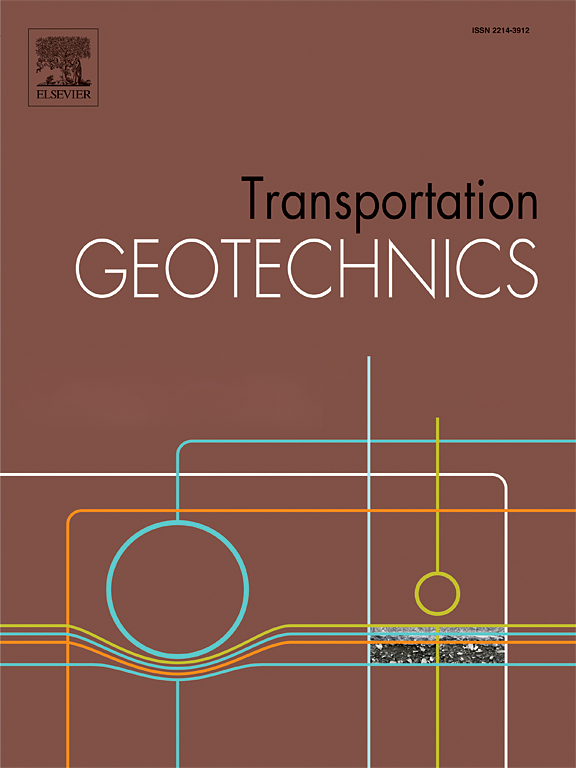An insight into the stability of unsaturated embankments with different suction profiles
IF 4.9
2区 工程技术
Q1 ENGINEERING, CIVIL
引用次数: 0
Abstract
As-compacted soil embankments are partially saturated and, during their lifetime, they experience changes in water content and suction according to interaction with the atmosphere and the groundwater table. However, conventional slope stability assessments often assume either dry or fully saturated conditions, which can lead to inaccurate predictions. This paper presents an analytical framework for the analysis of the stability of unsaturated embankments under different suction profiles. The limit equilibrium analysis is extended to unsaturated slopes by incorporating matric suction, degree of saturation, and rainfall infiltration. A novel design chart is introduced to illustrate the interplay between the hydromechanical parameters of the slope, its geometry, the position of the groundwater table, and the infiltration profile. The outcomes demonstrate the significance of suction and saturation distributions in the sustainable planning and safety evaluation of embankments, offering meaningful perspectives for enhancing design methodologies and prevent failures in unsaturated engineered slopes. A key finding is the identification of the transition infiltration depth, which delineates the shift from deep to shallow slip surfaces. If the wetting front remains above this threshold, the design chart remains applicable. However, if it extends beyond this depth, a more comprehensive stability analysis is required. The method has been successfully used to predict the safety factor of engineered slopes under different suction profiles. Serving also as a benchmark for more advanced stability analyses, the design chart provides engineers with a practical tool for integrating unsaturated soil behaviour into geotechnical design, enhancing risk assessment and failure prevention strategies.
对不同吸力剖面非饱和堤防稳定性的深入研究
压实土堤防部分饱和,在其生命周期中,根据与大气和地下水位的相互作用,它们的含水量和吸力会发生变化。然而,传统的边坡稳定性评估通常假设干燥或完全饱和的条件,这可能导致不准确的预测。本文提出了一种分析非饱和路堤在不同吸力剖面下稳定性的分析框架。通过考虑基质吸力、饱和程度和降雨入渗,将极限平衡分析扩展到非饱和边坡。采用一种新颖的设计图表来说明边坡的水力学参数、几何形状、地下水位位置和入渗剖面之间的相互作用。研究结果表明了吸力和饱和度分布在路堤可持续规划和安全评价中的重要性,为改进非饱和工程边坡的设计方法和防止破坏提供了有意义的观点。一个关键的发现是确定了过渡入渗深度,它描绘了从深部到浅层滑动面的转变。如果润湿锋仍然高于此阈值,则设计图仍然适用。但是,如果超出这个深度,则需要进行更全面的稳定性分析。该方法已成功地用于预测工程边坡在不同吸力剖面下的安全系数。作为更先进的稳定性分析的基准,设计图表为工程师提供了将非饱和土行为整合到岩土工程设计中的实用工具,增强了风险评估和破坏预防策略。
本文章由计算机程序翻译,如有差异,请以英文原文为准。
求助全文
约1分钟内获得全文
求助全文
来源期刊

Transportation Geotechnics
Social Sciences-Transportation
CiteScore
8.10
自引率
11.30%
发文量
194
审稿时长
51 days
期刊介绍:
Transportation Geotechnics is a journal dedicated to publishing high-quality, theoretical, and applied papers that cover all facets of geotechnics for transportation infrastructure such as roads, highways, railways, underground railways, airfields, and waterways. The journal places a special emphasis on case studies that present original work relevant to the sustainable construction of transportation infrastructure. The scope of topics it addresses includes the geotechnical properties of geomaterials for sustainable and rational design and construction, the behavior of compacted and stabilized geomaterials, the use of geosynthetics and reinforcement in constructed layers and interlayers, ground improvement and slope stability for transportation infrastructures, compaction technology and management, maintenance technology, the impact of climate, embankments for highways and high-speed trains, transition zones, dredging, underwater geotechnics for infrastructure purposes, and the modeling of multi-layered structures and supporting ground under dynamic and repeated loads.
 求助内容:
求助内容: 应助结果提醒方式:
应助结果提醒方式:


